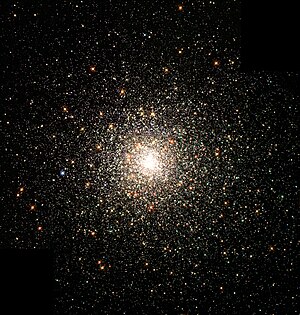Messier 80
| Messier 80 | |
|---|---|
 A Hubble Space Telescope (HST) image of M80 | |
| Observation data (J2000 epoch) | |
| Class | II[1] |
| Constellation | Scorpius |
| Right ascension | 16h 17m 02.41s[2] |
| Declination | –22° 58′ 33.9″[2] |
| Distance | 32.6 kly (10.0 kpc)[3] |
| Apparent magnitude (V) | 7.3[4] |
| Apparent dimensions (V) | 10.0′ |
| Physical characteristics | |
| Mass | 5.02×105[5] M☉ |
| Radius | 48 ly |
| Metallicity | = –1.47[6] dex |
| Estimated age | 13.5 ± 1.0 Gyr[7] |
| Other designations | M80, NGC 6093, GCl 39[8] |
Messier 80 (also known as M80 or NGC 6093) is a globular cluster in the constellation Scorpius. It was discovered by Charles Messier in 1781, being one of his first discoveries.[9]
This star cluster is, as to its angle from the solar system, midway between α Scorpii (Antares) and β Scorpii in a field in the Milky Way Galaxy that is rich in nebulæ. With low levels of light pollution it can be viewed below the 67th parallel north with modest amateur telescopes, appearing as a mottled ball of light.
It has an apparent angular diameter of about 10 arcminutes.[9] Since it is 32,600 light-years (10,000 pc) away, this translates into a true (spatial) diameter of about 95 light-years.[9] It contains several hundred thousand stars, and ranks among the densest globular clusters in the Milky Way.[9] It is at more than twice the distance of the Galactic Center in regions considered the Galactic halo.
It hosts relatively many blue stragglers, stars that appear to be much younger than the cluster. It is thought these have lost part of their outer layers due to close encounters with other cluster members or perhaps from collisions between stars in the dense cluster. Images from the Hubble Space Telescope have shown pronounced districts of these stragglers in M80, suggesting the center of the cluster to have a very high capture and collision rate.[9]
On May 21, 1860, a nova was found in M80 that delivered a magnitude of +7.0 to telescopes, binoculars and astute eyes.[9] This variable star, given designation T Scorpii, reached an absolute magnitude of −8.5, briefly outshining the cluster.[9]
Gallery
[edit]- M80 is on the far right edge of this image of Rho Ophiuchi cloud complex toward the top
- Map showing the location of M80
See also
[edit]References
[edit]- ^ Shapley, Harlow; Sawyer, Helen B. (August 1927), "A Classification of Globular Clusters", Harvard College Observatory Bulletin, 849 (849): 11–14, Bibcode:1927BHarO.849...11S.
- ^ a b Goldsbury, Ryan; et al. (December 2010), "The ACS Survey of Galactic Globular Clusters. X. New Determinations of Centers for 65 Clusters", The Astronomical Journal, 140 (6): 1830–1837, arXiv:1008.2755, Bibcode:2010AJ....140.1830G, doi:10.1088/0004-6256/140/6/1830, S2CID 119183070.
- ^ Paust, Nathaniel E. Q.; et al. (February 2010), "The ACS Survey of Galactic Globular Clusters. VIII. Effects of Environment on Globular Cluster Global Mass Functions", The Astronomical Journal, 139 (2): 476–491, Bibcode:2010AJ....139..476P, doi:10.1088/0004-6256/139/2/476, hdl:2152/34371, S2CID 120965440.
- ^ "Messier 80". SEDS Messier Catalog. Archived from the original on April 30, 2022. Retrieved April 30, 2022.
- ^ Boyles, J.; et al. (November 2011), "Young Radio Pulsars in Galactic Globular Clusters", The Astrophysical Journal, 742 (1): 51, arXiv:1108.4402, Bibcode:2011ApJ...742...51B, doi:10.1088/0004-637X/742/1/51, S2CID 118649860.
- ^ Forbes, Duncan A.; Bridges, Terry (May 2010), "Accreted versus in situ Milky Way globular clusters", Monthly Notices of the Royal Astronomical Society, 404 (3): 1203–1214, arXiv:1001.4289, Bibcode:2010MNRAS.404.1203F, doi:10.1111/j.1365-2966.2010.16373.x, S2CID 51825384.
- ^ Göttgens, Fabian; Kamann, Sebastian; Baumgardt, Holger; Dreizler, Stefan; Giesers, Benjamin; Husser, Tim-Oliver; Den Brok, Mark; Fétick, Romain; Krajnovic, Davor; Weilbacher, Peter M. (2021). "Central kinematics of the Galactic globular cluster M80". Monthly Notices of the Royal Astronomical Society. 507 (4): 4788–4803. arXiv:2108.11393. doi:10.1093/mnras/stab2449.
- ^ "M 80". SIMBAD. Centre de données astronomiques de Strasbourg. Retrieved November 16, 2006.
- ^ a b c d e f g "Messier 80". SEDS Messier Database. Students for the Exploration and Development of Space. Archived from the original on January 14, 2022. Retrieved December 19, 2021.
External links
[edit] Media related to Messier 80 at Wikimedia Commons
Media related to Messier 80 at Wikimedia Commons- Messier 80, SEDS Messier pages
- Messier 80, Galactic Globular Clusters Database page
- NASA Astronomy Picture of the Day: M80: A Dense Globular Cluster (July 7, 1999)
- Messier 80 at ESA/Hubble Archived February 9, 2009, at the Wayback Machine
- Messier 80 on WikiSky: DSS2, SDSS, GALEX, IRAS, Hydrogen α, X-Ray, Astrophoto, Sky Map, Articles and images


 French
French Deutsch
Deutsch![{\displaystyle {\begin{smallmatrix}\left[{\ce {Fe}}/{\ce {H}}\right]\end{smallmatrix}}}](https://wikimedia.org/api/rest_v1/media/math/render/svg/4c0821bd80891e071c08e7c7ee8e022baedf522c)


